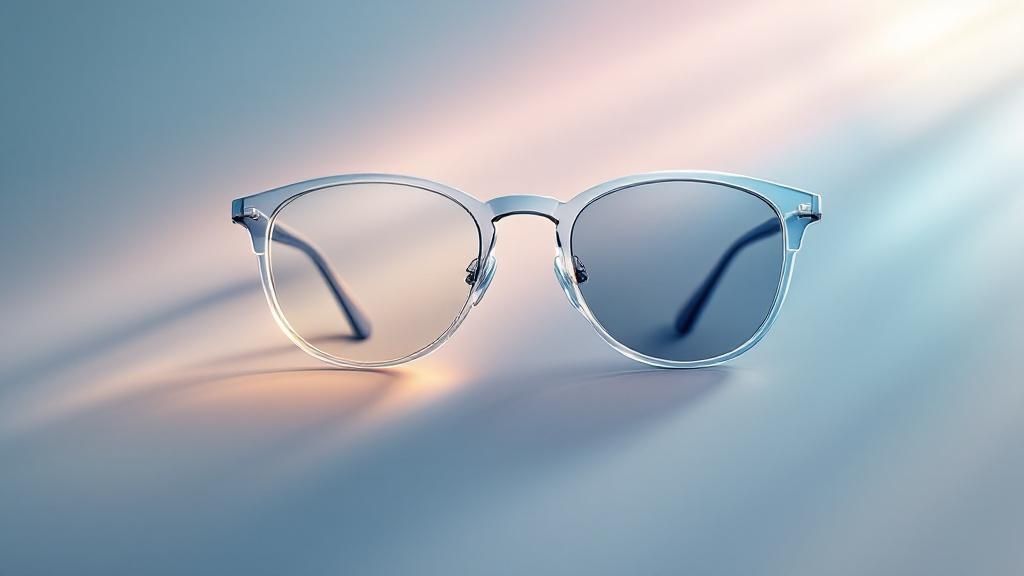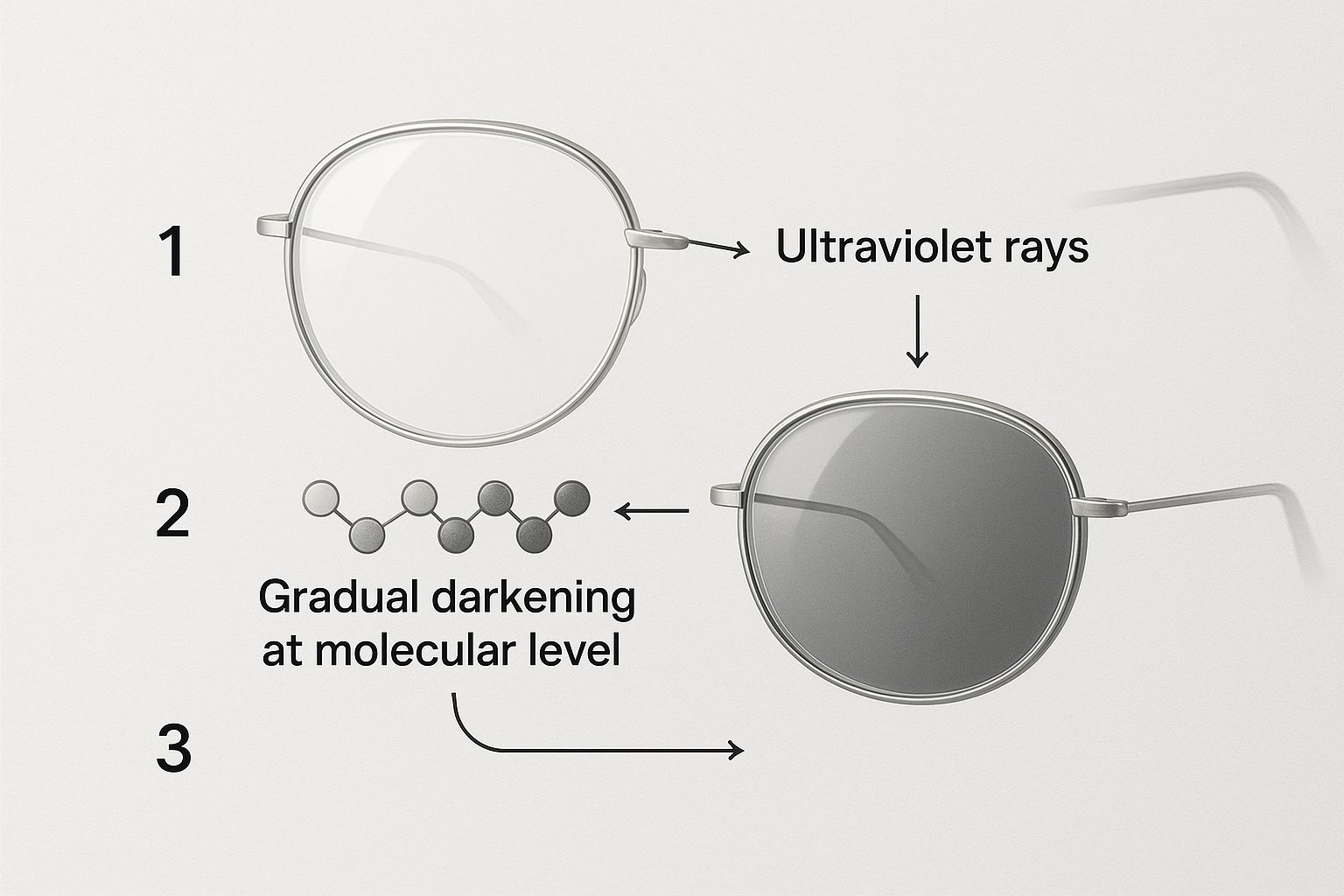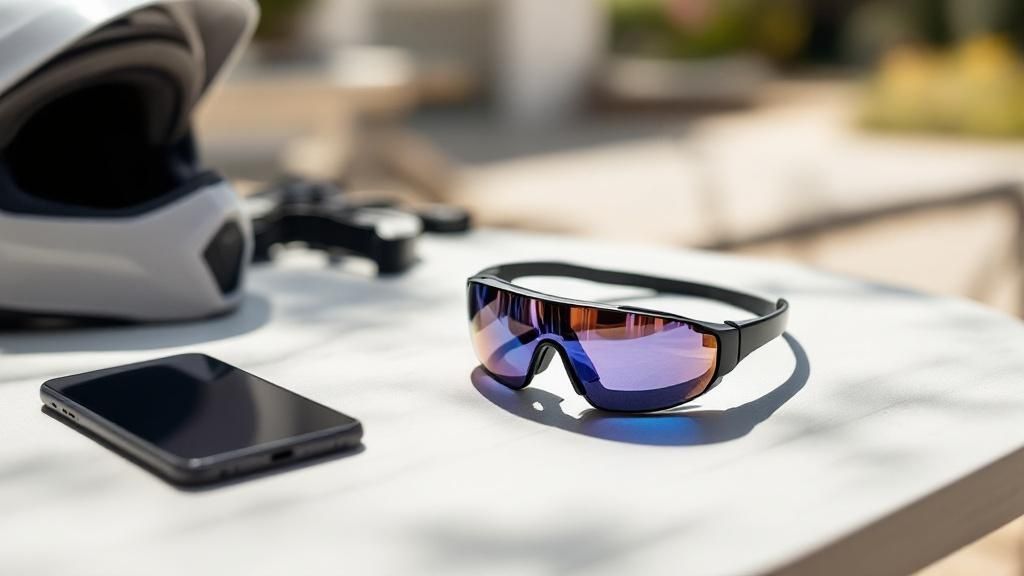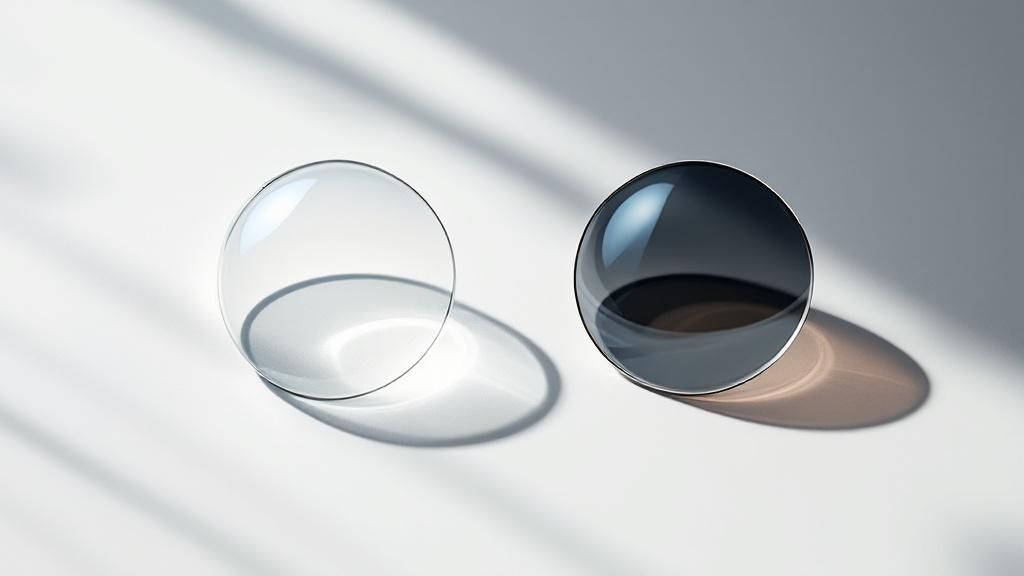
What Does Photochromic Mean And How Do Lenses Adapt?
Ever wondered how some glasses seem to have a mind of their own, magically darkening in the sun and turning perfectly clear again indoors? You've just stumbled upon photochromic technology.
Simply put, photochromic means the lenses automatically adapt to whatever light you're in. They give you crisp, clear vision inside and then transform into sunglasses the second you step out into the bright light.
The Secret Behind Self-Adjusting Glasses
Think of photochromic lenses as a smart, responsive shield for your eyes. Much like a chameleon that instantly changes its colors to match its surroundings, these lenses adjust their tint based on the amount of UV light they're exposed to. This offers the ultimate convenience by rolling your everyday glasses and your sunglasses into one seamless pair.
This chameleon-like ability means you can finally stop juggling multiple pairs of glasses. Whether you're working at your desk, walking to lunch, or enjoying a sunny afternoon, your vision stays comfortable and protected without you ever having to think about it.
The real beauty of it is the effortless adaptation. Your lenses do all the work, making sure your eyes are always shielded from harsh glare and harmful UV rays, which means less squinting and eye strain.
This technology isn't just a neat trick; it’s about creating a genuinely better, more comfortable visual experience day in and day out.
Photochromic Lenses At a Glance
To give you a quick rundown, here’s a simple table that breaks down what makes this technology so incredibly useful for daily life.
| Characteristic | Description |
|---|---|
| Light Adaptive | Lenses darken when exposed to UV light and become clear indoors or at night. |
| UV Protection | They block 100% of UVA and UVB rays, protecting your eyes at all times. |
| All-in-One Solution | Combines your prescription or non-prescription glasses and sunglasses into one convenient pair. |
| Reduces Eye Strain | By cutting down on glare in bright conditions, it minimizes squinting and visual fatigue. |
As you can see, the benefits go far beyond just convenience, offering a comprehensive solution for eye comfort and protection.
How These Smart Lenses Actually Work
The way photochromic lenses adapt isn't magic, though it certainly feels like it. It's actually some pretty brilliant chemistry. Deep inside the lens material, there are trillions of microscopic molecules just waiting for their moment to shine—or rather, to darken.
Think of these molecules like tiny engines powered by light. When you step out into the sun, they get hit with ultraviolet (UV) radiation. This blast of UV energy triggers a chemical reaction, causing the molecules to change their shape. As they shift, they start to absorb more visible light, and that’s what makes the lenses darken, turning your everyday glasses into a pair of sunglasses right before your eyes.
The moment you step back inside, away from the UV rays, the process reverses itself. The molecules snap back to their original, clear state, and your lenses become transparent again. This constant, seamless reaction is what gives them that smart, adaptive quality we love.
The image below gives you a peek at what's happening on that molecular level when the lens is exposed to UV light.

As you can see, those individual molecules literally open up to soak in the light, which creates the protective tint for your eyes.
Why They Do Not Always Work in a Car
One of the most common questions we get is why photochromic lenses don't seem to work inside a car. The answer is simple: it all comes down to their trigger, which is UV light.
Most modern car windshields are actually designed to protect you and your car's interior from sun damage. They do this by blocking nearly all UV rays. Since the windshield is filtering out the very light needed to kickstart that molecular change, your lenses never get the signal to darken. It's a classic case of the technology working perfectly, just not in the way you might expect. It also shows just how important it is to understand the impact of UV rays—you can learn more about how do UV rays affect your eyes in our full guide.
The Evolution from Glass to Smart Plastics
The adaptive lenses we love today didn't just appear out of nowhere. Their journey is a story of slow and steady improvement, kicking off in the 1960s with some early glass prototypes. While clunky, they proved the core concept was solid.
These first-generation glass lenses, developed by Corning, were pretty impressive for their time but came with some major downsides. They were heavy, and their reaction times—both for darkening in the sun and clearing up indoors—were painfully slow by modern standards. They introduced the world to the idea of photochromic tech, but for it to really take off, it had to get lighter and a whole lot quicker.
The real game-changer came when innovators began looking beyond glass and started experimenting with plastics. This shift from heavy, breakable glass to lightweight polymers was the key that finally unlocked the technology's full potential, making it practical enough for anyone to wear all day.
The Leap to Lightweight Plastics
The big moment came in the late 1980s. A company called Pittsburgh Plate Glass (PPG) poured resources into research and finally cracked the code for a successful plastic photochromic lens. This breakthrough, using a completely new family of chemicals, paved the way for the fast, efficient, and comfortable lenses we use in Spektrum Glasses today. You can dive deeper into the history of this optical innovation and its development.
This decades-long journey of research and refinement is what turned photochromic lenses from a niche curiosity into a high-performance vision tool. The focus wasn't just on making them react faster, but also on ensuring they were durable and looked good.
This evolution highlights a core principle of great design: taking a brilliant idea and relentlessly improving it until it seamlessly fits into our daily lives, offering both function and comfort.
Today's lenses are the direct descendants of that persistent drive, giving us a blend of advanced chemistry and practical design that their glass predecessors could only dream of.
Practical Benefits for Your Everyday Life
Beyond the fascinating science, the real magic of photochromic lenses is how they simplify your day. This technology is a fantastic blend of convenience, protection, and comfort that solves a lot of the common headaches that come with traditional glasses.

The first thing you'll notice is the unmatched convenience. You can finally stop juggling two pairs of glasses. Gone are the days of fumbling for your sunglasses when you step outside, only to forget and leave them on when you head back in. With photochromic lenses, you have one smart pair that does all the work for you.
This all-in-one approach just makes life easier, especially if you're always on the move. Whether you're running errands, grabbing lunch on a patio, or just walking to your car, your vision stays clear and comfortable without you having to think about it.
Constant, Effortless Protection
Maybe the most important benefit is the automatic and non-stop UV protection. Photochromic lenses are engineered to block 100% of harmful UVA and UVB rays, which is absolutely critical for your long-term eye health.
And this protection is always on. Since the darkening is triggered by invisible UV radiation, your lenses are protecting your eyes even on cloudy days. The sun might not feel bright, but those UV rays are still getting through.
This constant shield isn't just a cool feature; it’s a real commitment to your well-being. It helps protect your eyes from the cumulative damage the sun can cause, which is a huge part of keeping your vision healthy for years to come.
Understanding your own eye health is a big deal, and consistent UV protection is a major piece of that puzzle. You can learn more about how healthy are your eyes in our detailed guide.
Improved Visual Comfort and Reduced Strain
Squinting into the bright sun or dealing with light that’s constantly changing is just plain tiring for your eyes. Photochromic lenses tackle this head-on by automatically cutting down glare and managing the light intensity for you. Key advantages include:
- Less Squinting: As the lenses darken, they soften harsh brightness, letting your eye muscles relax.
- Reduced Eye Fatigue: Your eyes don't have to constantly work to adjust to different light levels, which helps minimize that tired, strained feeling at the end of the day.
- Enhanced Clarity: By filtering out overwhelming light, the lenses can actually improve contrast and make your vision sharper in bright conditions.
It all adds up to a more comfortable and relaxed visual experience, no matter what your day throws at you.
Comparing Photochromic Lenses to Other Options
So, how do photochromic lenses actually stack up against your trusty sunglasses or your everyday clear glasses? Honestly, picking the right lens really just comes down to your lifestyle. It's a classic trade-off between specialization and all-around versatility.
Dedicated sunglasses, for instance, give you a consistent, dark tint that's fantastic in super bright, direct sunlight. But that single-purpose design means they're practically useless the second you step inside, forcing you to constantly juggle pairs. On the flip side, standard clear lenses are perfect for indoor work or low-light situations but leave you squinting with zero protection from outdoor glare.
Photochromic lenses carve out a pretty unique space right in the middle. Think of them as the ultimate all-in-one solution, bridging that annoying gap between your indoor and outdoor needs. This adaptability is their superpower.

A Head-to-Head Breakdown
To make the choice a little easier, let's put these three lens types side-by-side and look at what really matters for daily use: convenience, protection, and adaptability. Seeing how they perform helps clarify which one truly fits your routine. The simplicity of adaptive lenses is a huge draw for many, and you can dive deeper into the advantages of transition lenses to see if they're right for you.
To really get to the heart of it, let's break down how these lenses compare in a simple table. This will give you a quick, at-a-glance look at where each type shines and where it falls short.
Lens Comparison: Photochromic vs. Sunglasses vs. Clear Lenses
| Feature | Photochromic Lenses | Polarized Sunglasses | Standard Clear Lenses |
|---|---|---|---|
| Adaptability | Excellent: Automatically adjusts tint to any light. | Poor: Fixed tint is only useful in bright sun. | Poor: No tint; ineffective against glare. |
| Convenience | Excellent: One pair for both indoors and outdoors. | Fair: Requires carrying a second pair of glasses. | Fair: Must be swapped for sunglasses outdoors. |
| UV Protection | Excellent: Blocks 100% of UVA/UVB rays constantly. | Good: Blocks UV, but only when you wear them. | Poor: Typically offers no UV protection on its own. |
As you can see, the core difference is how they handle changing light. While traditional lenses are static, photochromic technology is dynamic, constantly working to give your eyes just the right amount of light.
Ultimately, the table makes it clear: photochromic lenses deliver a balanced, incredibly convenient option that puts both protection and ease of use first, freeing you from ever having to compromise.
Common Questions About Photochromic Lenses
Even after you understand what photochromic means and how the magic happens, a few practical questions usually pop up. While the technology is incredibly useful, its performance can be affected by real-world factors like temperature and plain old age. Let's tackle some of the most common curiosities to give you the full picture.
Knowing these details helps you set the right expectations for your adaptive lenses, ensuring you get the most out of your investment in clear, comfortable vision.
Do Photochromic Lenses Wear Out Over Time?
Yes, just like any other piece of high-performance gear, photochromic lenses can show wear over time. The molecules that do all the work—darkening in the sun and clearing up indoors—go through a fatigue process with every cycle. After a few years, you might notice they don't get quite as dark as they used to, or they take a bit longer to turn clear again.
But don't worry, modern lenses are built to last. To get the most mileage out of them:
- Store them properly: When you’re not wearing your glasses, keep them in their case and away from direct sunlight.
- Avoid extreme heat: Never, ever leave your glasses on a hot car dashboard. High temperatures can cook the photochromic compounds and speed up their breakdown.
With just a little care, a quality pair of photochromic lenses will serve you well for years.
How Does Temperature Affect How They Work?
Temperature plays a surprisingly big role in your lenses' performance. You've probably noticed your lenses get darker and stay dark longer when it's cold. This isn't your imagination—it's chemistry. The reaction that allows the molecules to return to their clear state is powered by thermal energy (heat).
In cold weather, there's less heat available, so the molecules are slower to change back and stay in their darkened form longer. The opposite happens in very hot weather. Your lenses will clear up faster but might not reach their absolute darkest shade because the heat is constantly encouraging the molecules to revert to their clear state.
Think of it this way: cold weather makes the molecules sluggish, keeping them dark. Warm weather gives them a jolt of energy, helping them turn clear faster. It's a completely normal part of how they work.
Are "Transitions" and "Photochromic" the Same Thing?
This is a classic point of confusion, so let's clear it up. "Photochromic" is the scientific name for the technology itself—any lens that darkens automatically in response to UV light. "Transitions" is simply the most well-known brand name, kind of like how Kleenex is a brand of tissue or Xerox is a brand of copier.
Transitions Optical really put plastic photochromic lenses on the map when they launched their first commercially successful version back in 1990 by infusing special dyes into the lens. They've released many new and improved generations since then. You can dive deeper into the evolution of photochromic lens technology if you're curious. Today, while Transitions is a huge player, plenty of other fantastic manufacturers produce their own high-quality photochromic lenses.
Ready to experience the ultimate in convenience and eye protection? The advanced photochromic technology in Spektrum Glasses offers seamless adaptation, constant UV protection, and superior visual comfort in one stylish package.
Explore the Spektrum collection today and find your perfect pair.
